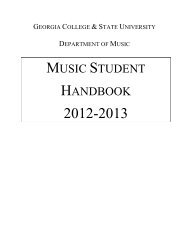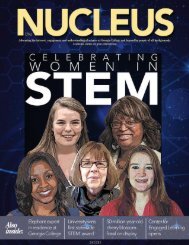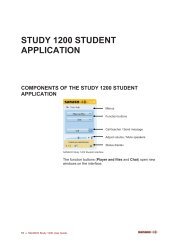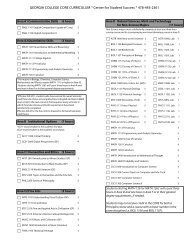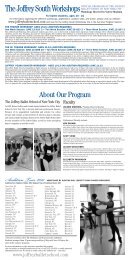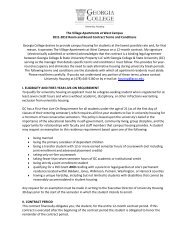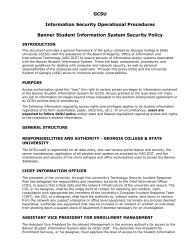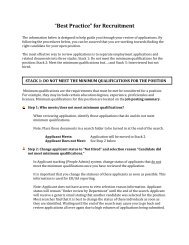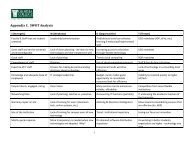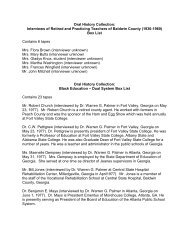The Great Fossil Find (pdf)
The Great Fossil Find (pdf)
The Great Fossil Find (pdf)
Create successful ePaper yourself
Turn your PDF publications into a flip-book with our unique Google optimized e-Paper software.
<strong>The</strong> <strong>Great</strong><br />
<strong>Fossil</strong> <strong>Find</strong>
<strong>The</strong> <strong>Great</strong> <strong>Fossil</strong> <strong>Find</strong><br />
GPS<br />
Kindergarden: SKCS1<br />
1 st Grade: S1CS1<br />
2 nd Grade: S2CS1<br />
3 rd Grade: S3CS1, S3E2<br />
4 th Grade: S4CS1, ELA4SLV1<br />
5 th Grade: S5CS1, ELA5SLV1<br />
6 th Grade: S6CS1, ELA6SLV1<br />
7 th Grade: S7CS1, ELA7SLV1<br />
Objective: Students will connect with the exhibits in the Natural History Museum and Planetarium by<br />
completing a fictional paleontological dig and study. This activity may be done in the classroom with the<br />
provided materials or use the fossils in the Natural History Museum as comparative material.<br />
This activity was originally designed by Steve Randak and Michael Kimmel . When using cite and for<br />
more information go to: http://www.indiana.edu/~ensiweb/lessons/gr.fs.fd.html.<br />
Pre-visit activities: Students will better understand and learn from this activity by being exposed to the<br />
following topics before their trip to the Natural History Museum and Planetarium.<br />
- fossils, geologic time scale, skeletons, paleontologist<br />
Post-visit activities: Students will more likely connect and retain information from the resources in the<br />
Natural History Museum and Planetarium by doing post-visit activities that requires use of the<br />
information to complete certain tasks. <strong>The</strong>se tasks may include:<br />
- Have groups of students compare their findings. Discuss points made at the website about what<br />
‘science’ is exactly.<br />
- Have students complete the two page worksheet at the end of this file and discuss their answers<br />
to the questions.<br />
- As part of the lesson complete the Poster instructions located at:<br />
http://www.indiana.edu/~ensiweb/lessons/gff.post.<strong>pdf</strong>.<br />
Notes: <strong>The</strong> animal in the skeleton manual that most closely resembles the fossil is the pterosaur. <strong>The</strong>re<br />
is a pterosaur fossil in the Natural History Museum in the “Age of Reptiles” exhibit.
<strong>The</strong> <strong>Great</strong> <strong>Fossil</strong> <strong>Find</strong><br />
In this activity, you and your partner will play the roles<br />
of paleontologists working in the field in Montana, near<br />
the town of Ekalaka. One clear crisp afternoon in October,<br />
you find four well preserved and complete fossils.<br />
Open envelope 1 and remove 4 fossils.<br />
Day 1: That night in camp, after dinner, around a Coleman<br />
lantern, you and your colleagues begin to assemble the 4<br />
bones you found earlier. Since the bones were all found<br />
together in an undisturbed layer, you assume that they are<br />
all from the same animal. You spend the rest of the<br />
evening trying different arrangements of the bones in<br />
hopes of identifying the animal before you get tired.<br />
Take 5 minutes to assemble the bones and make notes in<br />
your data chart. What kind of animal do you think this is?<br />
Day 2: You wake up to a beautiful Montana morning and you hurry back out to the dig site. <strong>The</strong> rock layers<br />
that hold your fossils are very hard and only give up three more specimens. As the day ends you make your<br />
way back to camp for another try at assembling the mystery animal.<br />
Open envelope 2 and remove 3 fossils.<br />
Take 5 minutes to assemble all 7 bones and make notes in your data chart.<br />
What kind of animal do you think this is now?<br />
Day 3: <strong>The</strong> next morning is cold. You can tell that winter is just around the corner and you know that this<br />
will be the last day of the digging season, and your last chance to find more fossils of the mystery animal.<br />
Just as the day is about to end, one of the members of your team finds 3 final bones.<br />
Open envelope 3 and remove 3 fossils.<br />
Take 5 minutes to assemble all 10 bones and make notes in your data chart.<br />
What kind of animal do you think this is now?<br />
Day 4: Back in the lab, you meet up with some paleontologist friends. <strong>The</strong>y tell you they have spent the<br />
summer working in a different location but within the same geological period. You show them the skeleton<br />
you found, and they tell you they have a similar one, but it looks like they have some different bones that<br />
you don’t have.
For 5 minutes, compare your fossils with those of a group near you, looking for clues that will help you<br />
assemble your fossils. Apply these clues to your interpretation of your skeleton. What type of animal do<br />
you think you have now?<br />
Day 5: (If doing this activity in the classroom) In the library at school you find a Skeletal Resource<br />
Manual with drawings of the skeletons of some existing animals. You notice some interesting<br />
similarities between some of the drawings and your unknown fossil.<br />
OR<br />
Day 5: (If doing this activity in the Natural History Museum) Your research team decides to travel to the<br />
nearest Natural History Museum to compare the fossils there with the specimens that you have to try to<br />
identify the animal. You notice some interesting similarities between some of the fossils on exhibit and<br />
your unknown fossil.<br />
Use the drawings or museum exhibits to assist you in your final assembly of the fossil skeleton. Fill in the<br />
data table with your final interpretation of the skeleton.
<strong>The</strong> <strong>Great</strong> <strong>Fossil</strong> <strong>Find</strong><br />
Names:___________________________________________<br />
Please complete the table below and turn in ONE for your entire group.<br />
What do<br />
your fossils<br />
look like?<br />
What type of<br />
animal do you<br />
think it is?<br />
What about<br />
the fossil<br />
makes you<br />
think that?<br />
Day 1 Day 2 Day 3 Day 4 Day 5
<strong>The</strong> <strong>Great</strong> <strong>Fossil</strong> <strong>Find</strong><br />
SKELETAL<br />
RESOURCE<br />
MANUAL
FISH (perca)<br />
SALAMANDER (Necturus)<br />
FROG (rana)
CAT (Felis)<br />
RABBIT (Lepus)
Fruit BAT (pteropus)<br />
BIRD (Columba)
Dinosaur (Tyrannosaurus)<br />
Pterosaur (Pterodactyl)
<strong>The</strong> <strong>Great</strong> <strong>Fossil</strong> <strong>Find</strong><br />
Names:___________________________________________<br />
Each person in your group must complete this worksheet individually.<br />
1. What does a paleontologist do?<br />
2. What assumptions did you make at the beginning of the activity that made it more<br />
difficult for you to assemble your final interpretation of the fossils?<br />
3. Did the discovery of new bones cause any conflict within your group? Why or why not?<br />
4. Did any of your group members resist changing their interpretation in light of the new<br />
information? Why did they do this?<br />
5. What information did you get from another group? How did it influence your<br />
assumptions?<br />
6. Did the information in the resource book confirm your group’s ideas, or did it cause<br />
you to rework your arrangement of the fossil parts? Explain how.<br />
7. Do you think this activity would have been easier or harder to do by yourself? What<br />
about with more than 2 people?<br />
8. Do you think this scenario is typical of how scientists create and revise hypotheses?<br />
<strong>The</strong> <strong>Great</strong> <strong>Fossil</strong> <strong>Find</strong>
Names:___________________________________________<br />
9. What does your experience with this scenario tell you about the work of scientists?<br />
10. From looking at the resource manual or natural history museum exhibits, what could<br />
you say about how and where this animal lived?<br />
11. How is it possible for scientists to do studies about things that happened millions of<br />
years ago?<br />
12. What do you think were the 3 main goals of this activity?



